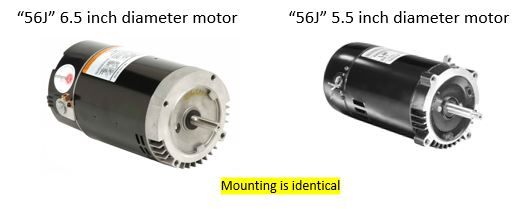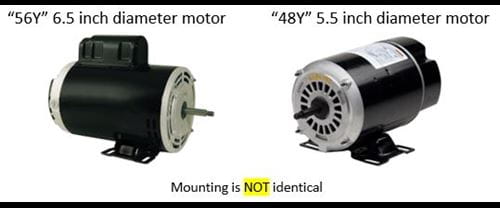
Demystifying pool and spa electric motor nameplates
May 2019
Please note - these guidelines are specific to pool and spa motors. Other motor types, especially larger horsepower industrial motors, may have different codes/definitions on their nameplates.
Understanding how to decipher motor nameplates can make choosing the right replacement motor for your application much easier. An electric motor’s nameplate can help users determine crucial information like that motor’s:
- rated voltage(s)
- rated full-load amps for each voltage level
- frequency
- phase
- rated full-load speed
- insulation class
- rated ambient temperature
- rated horsepower
- frame size and other items.
Read on for helpful information and tips from Hank Wiseman, one of Nidec Motor Corporation’s knowledgeable Pool and Spa Business Development Associates, on how to decipher motor nameplates.
Model Number
Model numbers are used by the manufacturers to identify specific motor configurations. The model number generally appears near the top of motor nameplates. When replacing a pool or spa motor, you may find a motor made specifically for original equipment manufacturers (OEM) or a replacement motor that was put on the pump. OEM-specific models will only show a model number and a customer part number.
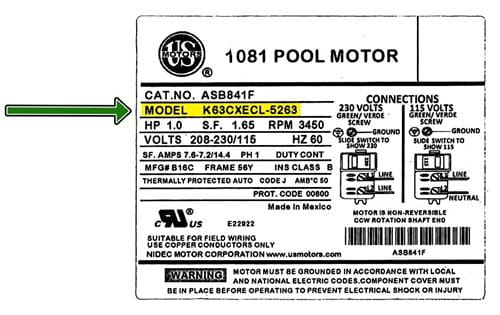
Typically, replacement motors will have a catalog number and a model number. An easy way to research a motor’s catalog number is to use the cross reference tool on usmotors.com.
Understanding the model number can help identify the type of motor. The first letters and set of numbers can tell you the type of motor and the diameter.
| First Letter | Meaning |
| K | Permanent Split Capacitor |
| C | Capacitor Start |
| B | Permanent Split Capacitor – Two Speed |
| M | Variable Speed Motor |
| P | Three Phase Motor |
| Second Following Numbers | Frame Size |
| 63 | 6.5" Diameter |
| 55 | 5.6" Diameter |
| 48 | 4.9" Diameter |
The 2-digit number ties to the lamination diameter, but can be used to determine the frame size.
The motor above is a 6.5" diameter frame with a permanent split capacitor electrical design.
Date Code
Date codes can vary from manufacturer to manufacturer. The way that U.S. MOTORS® brand nameplates typically handle date codes is as follows: XL18X. This date code means that the product was manufactured in November of 2018. The “X” represents possible plant codes that may or may not be present on a specific nameplate. The month code “L” is followed by a two-digit year code “18.”
| Code Key | Month |
| A | January |
| B | February |
| C | March |
| D | April |
| E | May |
| F | June |
| G | July |
| H | August |
| J | September |
| K | October |
| L | November |
| M | December |
Voltage
The listed voltage should indicate the voltage that a motor is designed to operate within. The motor should work within +/- 10% of the voltage indicated on the nameplate. The rated voltage “230/115” = 208-254 & 104-127 operating voltage under load. Low supply voltage can sometimes be compensated for with “spread” voltage design (rated “208-230” volts) or by choosing a larger-sized HP. High or Low voltage can cause protector trips or capacitor failures. Designs are usually optimized at nominal rated volts. The slash (/) indicates different connection between voltages (e.g. capable of 115 or 230 volts). The dash (-) indicates a range of voltages with no connection change (e.g. capable of +/- %10 at 208 or 230).

Service Factor Amps
Manufacturers often design motors with the ability to continue operating under a temporarily increased demand. The listed service factor amps amount represents the current draw when the motor is loaded to the service factor or maximum horsepower. Leisure water pump motors (jetted tub, spa and pool pump) always have the service factor (same as “max”) amps listed somewhere on the nameplate, although full load amps may also appear. In general, all pump motors are designed to run continuously at service factor, and the pump manufacturers load accordingly.

Frequency
The listed frequency indicates the amount of alternations (positive and negative peaks) per second that “AC” voltage has and is measured in Hertz. Note that on older motors, it may also be called “Alts.” In that case, it is useful to know that 120 Alts = 60 Hz in North America and certain other locations. In most of the rest of the world, it is 50 Hz. In Japan, this figure varies; sometimes it is 60 Hz and sometimes 50 Hz depending on the area. Frequency determines an induction motor top speed. Motors that run on 50 Hz run at 5/6 the speed (2850 RPM) of a motor rated at 60 Hz (3450 RPM). Variable speed motors will be rated for the input frequency to the drive but the motor speed is determined by the drive's output frequency.
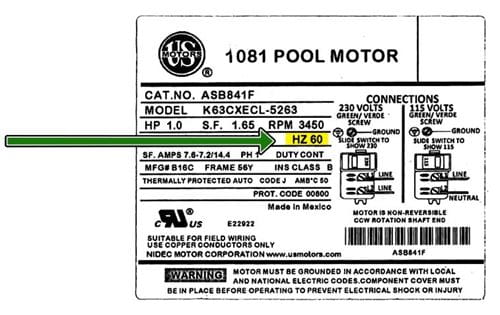
Ambient Temperature
Ambient temperature represents the max temperature of the air allowed around the motor. Higher-than-rated ambient temperatures at operating condition can result in decreased component life and possible “nuisance” overload trips. Most motors are rated 40°C (104°F); including jetted tub, aboveground pool and water system pump motors. Ambient ratings of 50°C (122°F) are common in inground pool pump motors; 60°C is required in some spa applications.
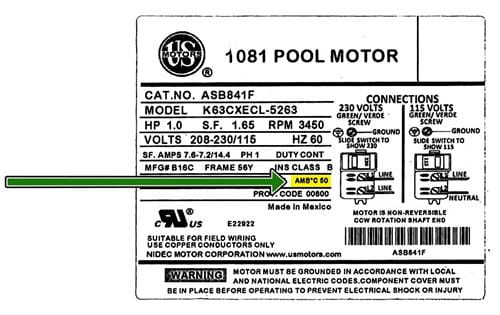
Phase
Electrical phase is the type of alternating current being supplied by the electric utility. Single phase electricity is the most common in a residential setting. Three phase electricity is common in industrial or commercial settings. Large filtration motors used in commercial motors may be single or three phase designs. It is important to match the phase of the motor to the phase of the incoming electricity.

A 3 Phase Motor Nameplate
Frame Size and Mounting
Frame size and mounting can cause a lot of confusion when choosing the right pool or spa replacement motor. In-ground pool pumps typically use a square or C-Flange mounting. The frame size is not as important in these applications, because the mounting will be identical. Above-ground and spa motors use a thru-bolt mounting and the frame size is a critical feature. A 56Y and 48Y thru-bolt motor will not be interchangeable.
Square Flange Motors
C-Flange Motors
Thru-Bolt Motors
Hank Wiseman is a Business Development Associate at Nidec Motor Corporation. Hank works in the leisure water segment helping connect pool and spa customers to Nidec solutions. Hank is pursuing his MBA at Southern Illinois University at Edwardsville where he received his Mechanical Engineering degree.





